Customer Experience Improvement: Strategic Report on Marks & Spencer
VerifiedAdded on 2023/06/10
|12
|3299
|448
Report
AI Summary
This report provides a comprehensive analysis of customer experience management, focusing on Marks & Spencer as a case study. It begins by outlining the company's value proposition, emphasizing its commitment to quality clothing and healthy food at competitive prices. The report then explores how this value proposition manifests in the customer experience, detailing the company's efforts to maintain a strong market image through high-quality goods and excellent after-sales service. An STP analysis identifies and segments Marks & Spencer's customer base by demographics, particularly age, and targets them based on spending level and income. The report further assesses the company's customer experience using the six pillars model—personalization, integrity, expectations, resolution, time and effort, and empathy—and provides strategic recommendations for improvement, including leveraging digital disruption to enhance customer engagement. The analysis concludes with insights into how Marks & Spencer can improve its customer experience to benefit both customers and the organization.

Customer Experience
Paraphrase This Document
Need a fresh take? Get an instant paraphrase of this document with our AI Paraphraser
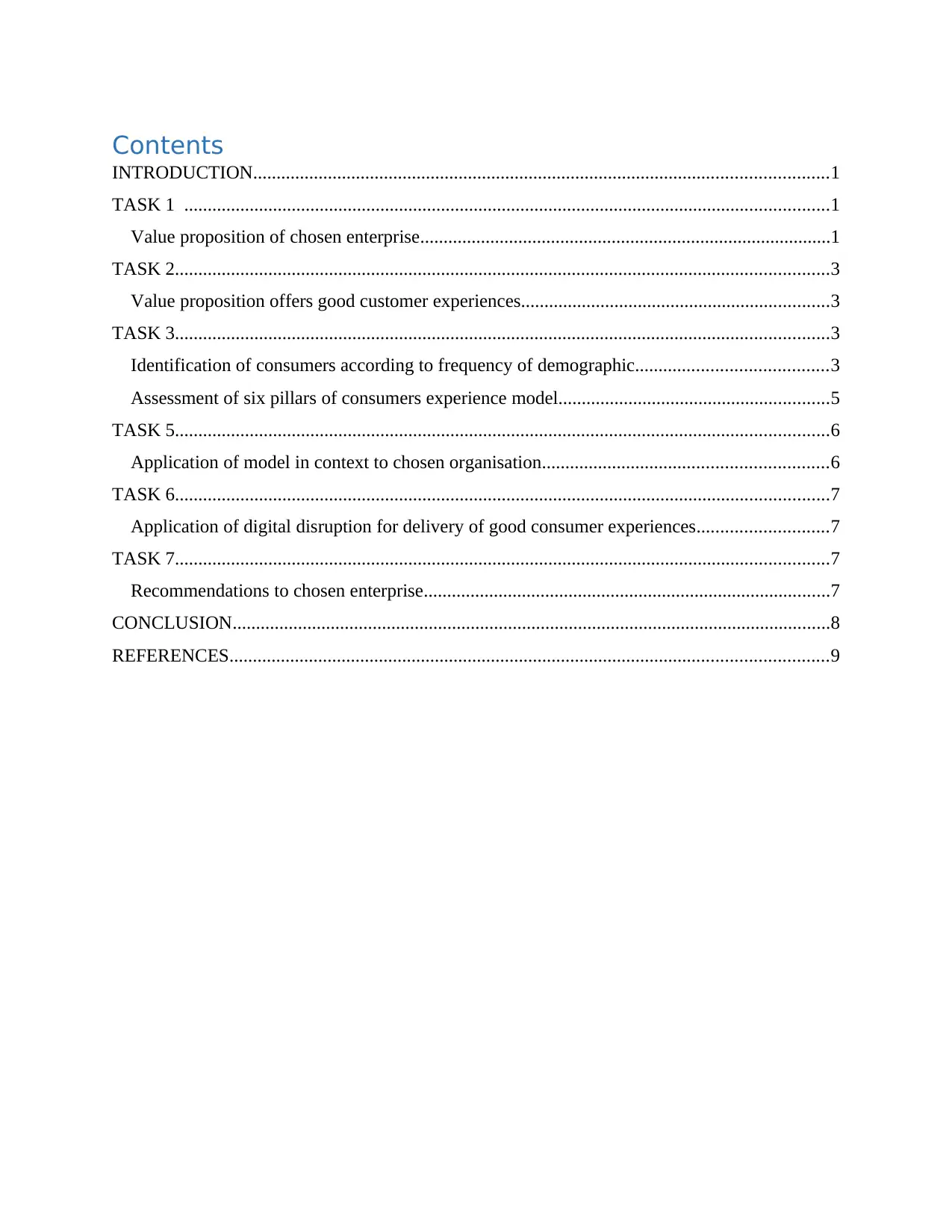
Contents
INTRODUCTION...........................................................................................................................1
TASK 1 ..........................................................................................................................................1
Value proposition of chosen enterprise........................................................................................1
TASK 2............................................................................................................................................3
Value proposition offers good customer experiences..................................................................3
TASK 3............................................................................................................................................3
Identification of consumers according to frequency of demographic.........................................3
Assessment of six pillars of consumers experience model..........................................................5
TASK 5............................................................................................................................................6
Application of model in context to chosen organisation.............................................................6
TASK 6............................................................................................................................................7
Application of digital disruption for delivery of good consumer experiences............................7
TASK 7............................................................................................................................................7
Recommendations to chosen enterprise.......................................................................................7
CONCLUSION................................................................................................................................8
REFERENCES................................................................................................................................9
INTRODUCTION...........................................................................................................................1
TASK 1 ..........................................................................................................................................1
Value proposition of chosen enterprise........................................................................................1
TASK 2............................................................................................................................................3
Value proposition offers good customer experiences..................................................................3
TASK 3............................................................................................................................................3
Identification of consumers according to frequency of demographic.........................................3
Assessment of six pillars of consumers experience model..........................................................5
TASK 5............................................................................................................................................6
Application of model in context to chosen organisation.............................................................6
TASK 6............................................................................................................................................7
Application of digital disruption for delivery of good consumer experiences............................7
TASK 7............................................................................................................................................7
Recommendations to chosen enterprise.......................................................................................7
CONCLUSION................................................................................................................................8
REFERENCES................................................................................................................................9

⊘ This is a preview!⊘
Do you want full access?
Subscribe today to unlock all pages.

Trusted by 1+ million students worldwide

INTRODUCTION
Consumer experience is a collection of affective, sensory, cognitive and behavioural
consumer responses at all phases of consumption process involving pre purchase, intake and post
purchase phases. It focuses more on enhancing relationship of business and their customers. This
attribute contains of every engagement that happens between enterprises and customers
regardless of its transformation into buying decision. The main responsibility of business firms
about consumer experience is to make sure that their marketing unit adopts proper strategies that
are consumer oriented (Arici, Köseoglu and Sökmen, 2022). These aims to cover all those points
which can influence consumer decision journey. To better understand the attributes of customer
experiences, the company considered is Marks & Spencer. It is a British multinational retailer
headquartered in London, England specialises in selling clothing, beauty, home products and
food products.
This report covers comprehension of several principles associated with managing
consumer experiences. It highlights different aspects of customer experience and key factors for
managing that experience. It interprets how to monitor and measure consumer experience in
strategic manner.
TASK 1
Value proposition of chosen enterprise
Value proposition is considered as a promise about the value which will be delivered,
communicated and acknowledged. It is beliefs of consumers in companies about how they will
get value and experience from a certain product. It summarises the journey statements about why
should a customer will choose a certain product and service. This element makes an organisation
position differentiated from its rivals who provides same kind of services. It provides
opportunities for firms to attain competitive advantage in market over their rivals. For instance,
WordPress have a value proposition statement which comprises of designing a website in short
period of time (Batat, 2019). In context to Marks & Spencer, their value proposition is to aim on
branding and and provide quality clothing and healthy food choices at economic prices. This
facilitates them to segment market according to their affordability. Value proposition canvas is
termed as strategic framework which facilitates businesses to manufacture products that can
1
Consumer experience is a collection of affective, sensory, cognitive and behavioural
consumer responses at all phases of consumption process involving pre purchase, intake and post
purchase phases. It focuses more on enhancing relationship of business and their customers. This
attribute contains of every engagement that happens between enterprises and customers
regardless of its transformation into buying decision. The main responsibility of business firms
about consumer experience is to make sure that their marketing unit adopts proper strategies that
are consumer oriented (Arici, Köseoglu and Sökmen, 2022). These aims to cover all those points
which can influence consumer decision journey. To better understand the attributes of customer
experiences, the company considered is Marks & Spencer. It is a British multinational retailer
headquartered in London, England specialises in selling clothing, beauty, home products and
food products.
This report covers comprehension of several principles associated with managing
consumer experiences. It highlights different aspects of customer experience and key factors for
managing that experience. It interprets how to monitor and measure consumer experience in
strategic manner.
TASK 1
Value proposition of chosen enterprise
Value proposition is considered as a promise about the value which will be delivered,
communicated and acknowledged. It is beliefs of consumers in companies about how they will
get value and experience from a certain product. It summarises the journey statements about why
should a customer will choose a certain product and service. This element makes an organisation
position differentiated from its rivals who provides same kind of services. It provides
opportunities for firms to attain competitive advantage in market over their rivals. For instance,
WordPress have a value proposition statement which comprises of designing a website in short
period of time (Batat, 2019). In context to Marks & Spencer, their value proposition is to aim on
branding and and provide quality clothing and healthy food choices at economic prices. This
facilitates them to segment market according to their affordability. Value proposition canvas is
termed as strategic framework which facilitates businesses to manufacture products that can
1
Paraphrase This Document
Need a fresh take? Get an instant paraphrase of this document with our AI Paraphraser

match with preference of their targeted customers. Value proposition canvas model in terms of
Marks & Spencer is described below:
Illustration 1: Value proposition canvas. 2021
Source: Value proposition canvas. 2021
Customer profile- This factor is associated with needs, preferences and problems faced
by consumers. It is essential for business entities to conduct several activities like emotional,
social and functional to figure out multiple needs of their prospects customers ( Heshmati,
Saeednia and Badizadeh, 2019). Social jobs in relevance to Marks & Spencer is to put
impression on buyers by adopting ethical practices. Functional actions in context to Marks &
Spencer is to sell products by using multiple channels. Emotional job are associated with
providing goods and services by considering consumers preference in cognition.
Pains- These are associated with troubles, pessimist emotions and threats posed on
customers at time of making decision of buying or before that. In context to Marks & Spencer,
pains are related with goods that are offered to buyers at high price and food which lacks to gain
the attraction of customers.
Gains- This factor of value proposition canvas is associated with several affirmative
experiences and benefits which are gained by consumers in their purchasing journey (Klink,
Zhang and Athaide, 2020). In context to Marks & Spencer, this gains are trending fashion
clothing and healthy food options to customers.
2
Marks & Spencer is described below:
Illustration 1: Value proposition canvas. 2021
Source: Value proposition canvas. 2021
Customer profile- This factor is associated with needs, preferences and problems faced
by consumers. It is essential for business entities to conduct several activities like emotional,
social and functional to figure out multiple needs of their prospects customers ( Heshmati,
Saeednia and Badizadeh, 2019). Social jobs in relevance to Marks & Spencer is to put
impression on buyers by adopting ethical practices. Functional actions in context to Marks &
Spencer is to sell products by using multiple channels. Emotional job are associated with
providing goods and services by considering consumers preference in cognition.
Pains- These are associated with troubles, pessimist emotions and threats posed on
customers at time of making decision of buying or before that. In context to Marks & Spencer,
pains are related with goods that are offered to buyers at high price and food which lacks to gain
the attraction of customers.
Gains- This factor of value proposition canvas is associated with several affirmative
experiences and benefits which are gained by consumers in their purchasing journey (Klink,
Zhang and Athaide, 2020). In context to Marks & Spencer, this gains are trending fashion
clothing and healthy food options to customers.
2
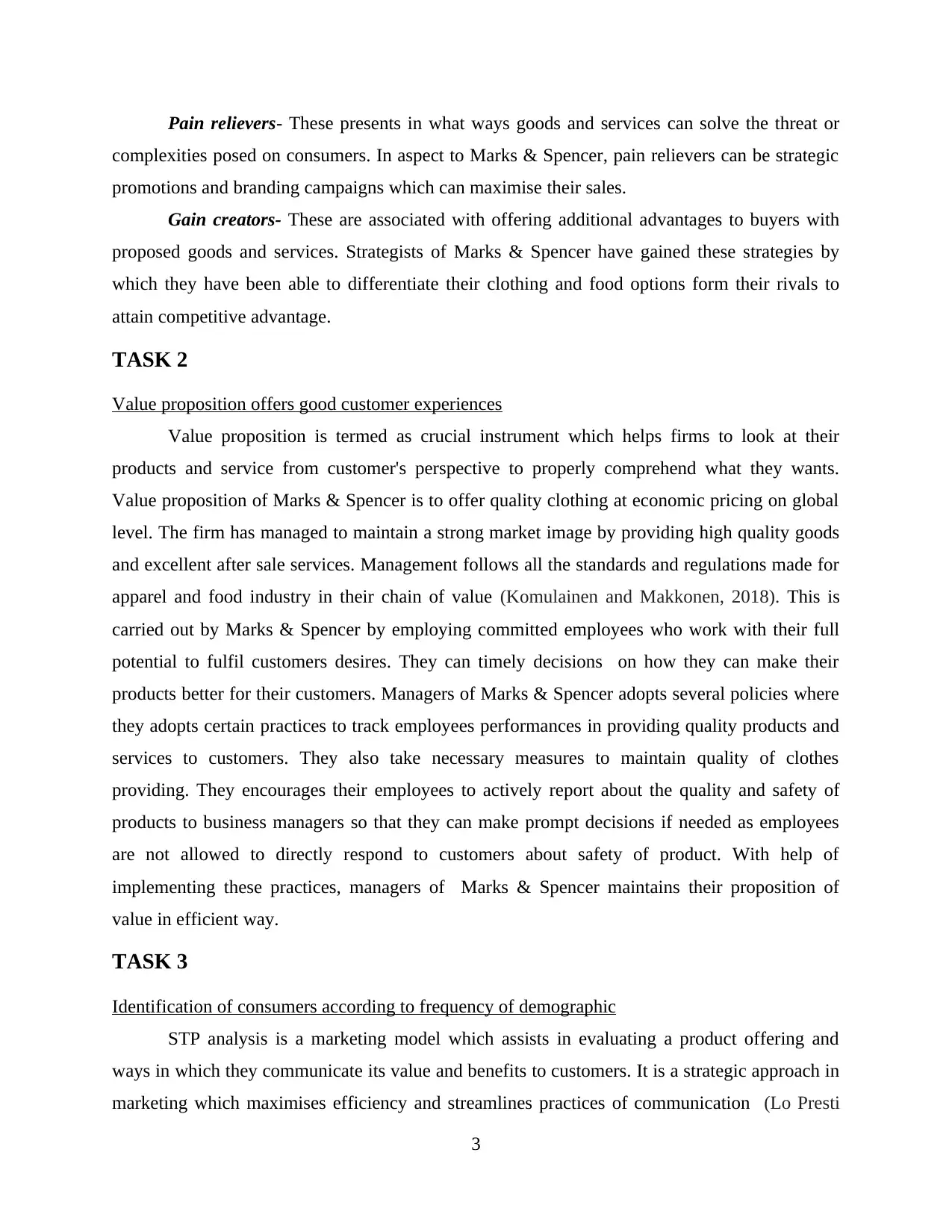
Pain relievers- These presents in what ways goods and services can solve the threat or
complexities posed on consumers. In aspect to Marks & Spencer, pain relievers can be strategic
promotions and branding campaigns which can maximise their sales.
Gain creators- These are associated with offering additional advantages to buyers with
proposed goods and services. Strategists of Marks & Spencer have gained these strategies by
which they have been able to differentiate their clothing and food options form their rivals to
attain competitive advantage.
TASK 2
Value proposition offers good customer experiences
Value proposition is termed as crucial instrument which helps firms to look at their
products and service from customer's perspective to properly comprehend what they wants.
Value proposition of Marks & Spencer is to offer quality clothing at economic pricing on global
level. The firm has managed to maintain a strong market image by providing high quality goods
and excellent after sale services. Management follows all the standards and regulations made for
apparel and food industry in their chain of value (Komulainen and Makkonen, 2018). This is
carried out by Marks & Spencer by employing committed employees who work with their full
potential to fulfil customers desires. They can timely decisions on how they can make their
products better for their customers. Managers of Marks & Spencer adopts several policies where
they adopts certain practices to track employees performances in providing quality products and
services to customers. They also take necessary measures to maintain quality of clothes
providing. They encourages their employees to actively report about the quality and safety of
products to business managers so that they can make prompt decisions if needed as employees
are not allowed to directly respond to customers about safety of product. With help of
implementing these practices, managers of Marks & Spencer maintains their proposition of
value in efficient way.
TASK 3
Identification of consumers according to frequency of demographic
STP analysis is a marketing model which assists in evaluating a product offering and
ways in which they communicate its value and benefits to customers. It is a strategic approach in
marketing which maximises efficiency and streamlines practices of communication (Lo Presti
3
complexities posed on consumers. In aspect to Marks & Spencer, pain relievers can be strategic
promotions and branding campaigns which can maximise their sales.
Gain creators- These are associated with offering additional advantages to buyers with
proposed goods and services. Strategists of Marks & Spencer have gained these strategies by
which they have been able to differentiate their clothing and food options form their rivals to
attain competitive advantage.
TASK 2
Value proposition offers good customer experiences
Value proposition is termed as crucial instrument which helps firms to look at their
products and service from customer's perspective to properly comprehend what they wants.
Value proposition of Marks & Spencer is to offer quality clothing at economic pricing on global
level. The firm has managed to maintain a strong market image by providing high quality goods
and excellent after sale services. Management follows all the standards and regulations made for
apparel and food industry in their chain of value (Komulainen and Makkonen, 2018). This is
carried out by Marks & Spencer by employing committed employees who work with their full
potential to fulfil customers desires. They can timely decisions on how they can make their
products better for their customers. Managers of Marks & Spencer adopts several policies where
they adopts certain practices to track employees performances in providing quality products and
services to customers. They also take necessary measures to maintain quality of clothes
providing. They encourages their employees to actively report about the quality and safety of
products to business managers so that they can make prompt decisions if needed as employees
are not allowed to directly respond to customers about safety of product. With help of
implementing these practices, managers of Marks & Spencer maintains their proposition of
value in efficient way.
TASK 3
Identification of consumers according to frequency of demographic
STP analysis is a marketing model which assists in evaluating a product offering and
ways in which they communicate its value and benefits to customers. It is a strategic approach in
marketing which maximises efficiency and streamlines practices of communication (Lo Presti
3
⊘ This is a preview!⊘
Do you want full access?
Subscribe today to unlock all pages.

Trusted by 1+ million students worldwide

and Maggiore, 2021). To properly assess consumers and position of products within market that
can result in providing competitive advantage to Marks & Spencer, STP analysis has been
considered. Several attributes of STP analysis in relevance to Marks & Spencer are described
underneath:
Segmenting- This element is associated with assignment of traits of whole consumer base
and segregate them into multiple different audiences as per data procured. It facilitates
companies to design better, relevant and engaging campaigns of market. It can be done in
various factors such as demographic which is related to age, ethnicity etc; geography such as
city, region, country etc; psychographics such as habits, personality traits etc. and behavioural
purchase such as interests, clicks browsing data etc (Nguyen, Kim-Duc and Freiburghaus, 2021).
In context to Marks & Spencer, managers choose to segment customers accordance to their age
in context to demographics attribute. Firm launched clothings for people of every age to attract
all age groups in the business. The major focus is on youth as firms produce clothes as per
transformation in fashion.
Targeting- Once firm have segmented their targets, they plan strategies on how to target
them in strategic manner. Procured data about segments can be used to target ideal segment in
terms of size as which segment is more large with high growth potential. Profitability which
determines lifetime value of customers to forecast segments profitability. And reachability which
shows customer acquisition cost fenced against profitability. In respect to Marks & Spencer,
management targets their segmented audiences on basis of their spending level and income.
Marks & Spencer offers high quality clothing products and fresh food at economical prices. They
takes in practices which are trending in market. For example, they relaunch high rise jeans
category as it came in fashion again and people highly demanded it.
Positioning- The major role of positioning is to connect enterprises to customers on
personal level in order to avoid competition. It is done to create some type of content which can
be resonate with consumers. It can be done in several types such as symbolic, functional and
experiential positioning (Pecorari and Lima, 2021). Effective positioning opportunities can
assists firms to respond to unfulfilled needs of customers in market. In context to Marks &
Spencer, managers use experiential positioning to meet demands of its customers by advertising
actively on social media platforms to aware people about new offerings. They assigns celebrities
to carry out their marketing campaigns and maintains personal relationships with them.
4
can result in providing competitive advantage to Marks & Spencer, STP analysis has been
considered. Several attributes of STP analysis in relevance to Marks & Spencer are described
underneath:
Segmenting- This element is associated with assignment of traits of whole consumer base
and segregate them into multiple different audiences as per data procured. It facilitates
companies to design better, relevant and engaging campaigns of market. It can be done in
various factors such as demographic which is related to age, ethnicity etc; geography such as
city, region, country etc; psychographics such as habits, personality traits etc. and behavioural
purchase such as interests, clicks browsing data etc (Nguyen, Kim-Duc and Freiburghaus, 2021).
In context to Marks & Spencer, managers choose to segment customers accordance to their age
in context to demographics attribute. Firm launched clothings for people of every age to attract
all age groups in the business. The major focus is on youth as firms produce clothes as per
transformation in fashion.
Targeting- Once firm have segmented their targets, they plan strategies on how to target
them in strategic manner. Procured data about segments can be used to target ideal segment in
terms of size as which segment is more large with high growth potential. Profitability which
determines lifetime value of customers to forecast segments profitability. And reachability which
shows customer acquisition cost fenced against profitability. In respect to Marks & Spencer,
management targets their segmented audiences on basis of their spending level and income.
Marks & Spencer offers high quality clothing products and fresh food at economical prices. They
takes in practices which are trending in market. For example, they relaunch high rise jeans
category as it came in fashion again and people highly demanded it.
Positioning- The major role of positioning is to connect enterprises to customers on
personal level in order to avoid competition. It is done to create some type of content which can
be resonate with consumers. It can be done in several types such as symbolic, functional and
experiential positioning (Pecorari and Lima, 2021). Effective positioning opportunities can
assists firms to respond to unfulfilled needs of customers in market. In context to Marks &
Spencer, managers use experiential positioning to meet demands of its customers by advertising
actively on social media platforms to aware people about new offerings. They assigns celebrities
to carry out their marketing campaigns and maintains personal relationships with them.
4
Paraphrase This Document
Need a fresh take? Get an instant paraphrase of this document with our AI Paraphraser
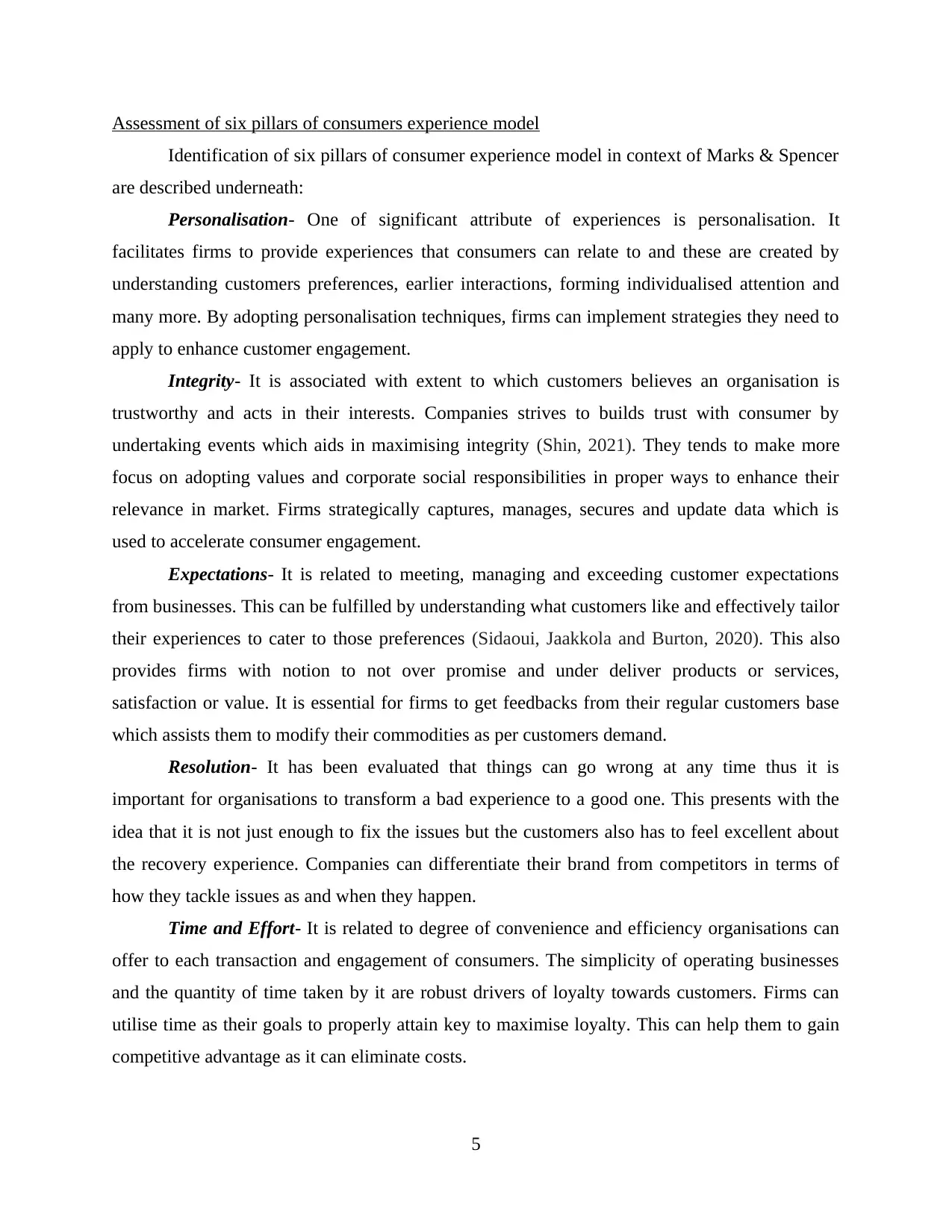
Assessment of six pillars of consumers experience model
Identification of six pillars of consumer experience model in context of Marks & Spencer
are described underneath:
Personalisation- One of significant attribute of experiences is personalisation. It
facilitates firms to provide experiences that consumers can relate to and these are created by
understanding customers preferences, earlier interactions, forming individualised attention and
many more. By adopting personalisation techniques, firms can implement strategies they need to
apply to enhance customer engagement.
Integrity- It is associated with extent to which customers believes an organisation is
trustworthy and acts in their interests. Companies strives to builds trust with consumer by
undertaking events which aids in maximising integrity (Shin, 2021). They tends to make more
focus on adopting values and corporate social responsibilities in proper ways to enhance their
relevance in market. Firms strategically captures, manages, secures and update data which is
used to accelerate consumer engagement.
Expectations- It is related to meeting, managing and exceeding customer expectations
from businesses. This can be fulfilled by understanding what customers like and effectively tailor
their experiences to cater to those preferences (Sidaoui, Jaakkola and Burton, 2020). This also
provides firms with notion to not over promise and under deliver products or services,
satisfaction or value. It is essential for firms to get feedbacks from their regular customers base
which assists them to modify their commodities as per customers demand.
Resolution- It has been evaluated that things can go wrong at any time thus it is
important for organisations to transform a bad experience to a good one. This presents with the
idea that it is not just enough to fix the issues but the customers also has to feel excellent about
the recovery experience. Companies can differentiate their brand from competitors in terms of
how they tackle issues as and when they happen.
Time and Effort- It is related to degree of convenience and efficiency organisations can
offer to each transaction and engagement of consumers. The simplicity of operating businesses
and the quantity of time taken by it are robust drivers of loyalty towards customers. Firms can
utilise time as their goals to properly attain key to maximise loyalty. This can help them to gain
competitive advantage as it can eliminate costs.
5
Identification of six pillars of consumer experience model in context of Marks & Spencer
are described underneath:
Personalisation- One of significant attribute of experiences is personalisation. It
facilitates firms to provide experiences that consumers can relate to and these are created by
understanding customers preferences, earlier interactions, forming individualised attention and
many more. By adopting personalisation techniques, firms can implement strategies they need to
apply to enhance customer engagement.
Integrity- It is associated with extent to which customers believes an organisation is
trustworthy and acts in their interests. Companies strives to builds trust with consumer by
undertaking events which aids in maximising integrity (Shin, 2021). They tends to make more
focus on adopting values and corporate social responsibilities in proper ways to enhance their
relevance in market. Firms strategically captures, manages, secures and update data which is
used to accelerate consumer engagement.
Expectations- It is related to meeting, managing and exceeding customer expectations
from businesses. This can be fulfilled by understanding what customers like and effectively tailor
their experiences to cater to those preferences (Sidaoui, Jaakkola and Burton, 2020). This also
provides firms with notion to not over promise and under deliver products or services,
satisfaction or value. It is essential for firms to get feedbacks from their regular customers base
which assists them to modify their commodities as per customers demand.
Resolution- It has been evaluated that things can go wrong at any time thus it is
important for organisations to transform a bad experience to a good one. This presents with the
idea that it is not just enough to fix the issues but the customers also has to feel excellent about
the recovery experience. Companies can differentiate their brand from competitors in terms of
how they tackle issues as and when they happen.
Time and Effort- It is related to degree of convenience and efficiency organisations can
offer to each transaction and engagement of consumers. The simplicity of operating businesses
and the quantity of time taken by it are robust drivers of loyalty towards customers. Firms can
utilise time as their goals to properly attain key to maximise loyalty. This can help them to gain
competitive advantage as it can eliminate costs.
5
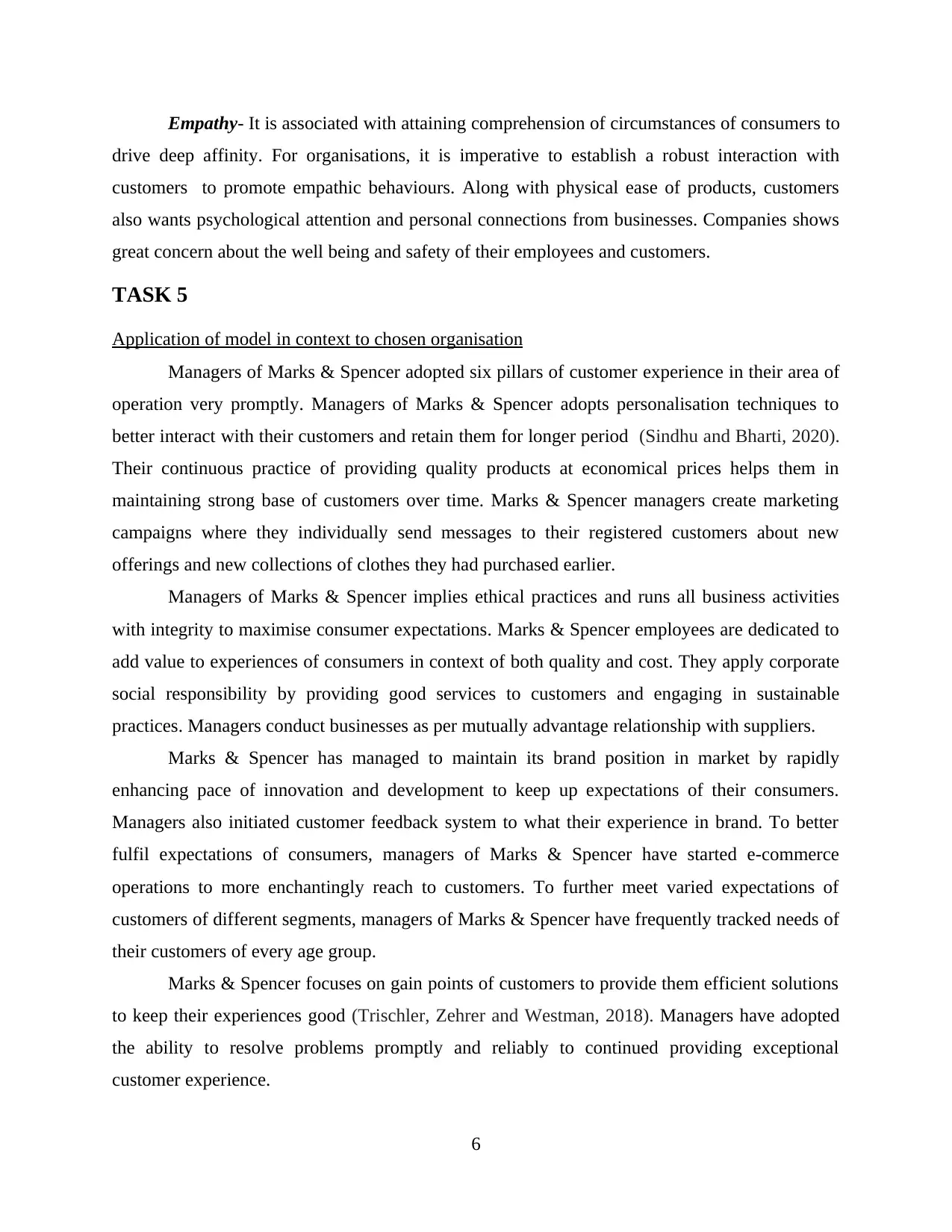
Empathy- It is associated with attaining comprehension of circumstances of consumers to
drive deep affinity. For organisations, it is imperative to establish a robust interaction with
customers to promote empathic behaviours. Along with physical ease of products, customers
also wants psychological attention and personal connections from businesses. Companies shows
great concern about the well being and safety of their employees and customers.
TASK 5
Application of model in context to chosen organisation
Managers of Marks & Spencer adopted six pillars of customer experience in their area of
operation very promptly. Managers of Marks & Spencer adopts personalisation techniques to
better interact with their customers and retain them for longer period (Sindhu and Bharti, 2020).
Their continuous practice of providing quality products at economical prices helps them in
maintaining strong base of customers over time. Marks & Spencer managers create marketing
campaigns where they individually send messages to their registered customers about new
offerings and new collections of clothes they had purchased earlier.
Managers of Marks & Spencer implies ethical practices and runs all business activities
with integrity to maximise consumer expectations. Marks & Spencer employees are dedicated to
add value to experiences of consumers in context of both quality and cost. They apply corporate
social responsibility by providing good services to customers and engaging in sustainable
practices. Managers conduct businesses as per mutually advantage relationship with suppliers.
Marks & Spencer has managed to maintain its brand position in market by rapidly
enhancing pace of innovation and development to keep up expectations of their consumers.
Managers also initiated customer feedback system to what their experience in brand. To better
fulfil expectations of consumers, managers of Marks & Spencer have started e-commerce
operations to more enchantingly reach to customers. To further meet varied expectations of
customers of different segments, managers of Marks & Spencer have frequently tracked needs of
their customers of every age group.
Marks & Spencer focuses on gain points of customers to provide them efficient solutions
to keep their experiences good (Trischler, Zehrer and Westman, 2018). Managers have adopted
the ability to resolve problems promptly and reliably to continued providing exceptional
customer experience.
6
drive deep affinity. For organisations, it is imperative to establish a robust interaction with
customers to promote empathic behaviours. Along with physical ease of products, customers
also wants psychological attention and personal connections from businesses. Companies shows
great concern about the well being and safety of their employees and customers.
TASK 5
Application of model in context to chosen organisation
Managers of Marks & Spencer adopted six pillars of customer experience in their area of
operation very promptly. Managers of Marks & Spencer adopts personalisation techniques to
better interact with their customers and retain them for longer period (Sindhu and Bharti, 2020).
Their continuous practice of providing quality products at economical prices helps them in
maintaining strong base of customers over time. Marks & Spencer managers create marketing
campaigns where they individually send messages to their registered customers about new
offerings and new collections of clothes they had purchased earlier.
Managers of Marks & Spencer implies ethical practices and runs all business activities
with integrity to maximise consumer expectations. Marks & Spencer employees are dedicated to
add value to experiences of consumers in context of both quality and cost. They apply corporate
social responsibility by providing good services to customers and engaging in sustainable
practices. Managers conduct businesses as per mutually advantage relationship with suppliers.
Marks & Spencer has managed to maintain its brand position in market by rapidly
enhancing pace of innovation and development to keep up expectations of their consumers.
Managers also initiated customer feedback system to what their experience in brand. To better
fulfil expectations of consumers, managers of Marks & Spencer have started e-commerce
operations to more enchantingly reach to customers. To further meet varied expectations of
customers of different segments, managers of Marks & Spencer have frequently tracked needs of
their customers of every age group.
Marks & Spencer focuses on gain points of customers to provide them efficient solutions
to keep their experiences good (Trischler, Zehrer and Westman, 2018). Managers have adopted
the ability to resolve problems promptly and reliably to continued providing exceptional
customer experience.
6
⊘ This is a preview!⊘
Do you want full access?
Subscribe today to unlock all pages.

Trusted by 1+ million students worldwide
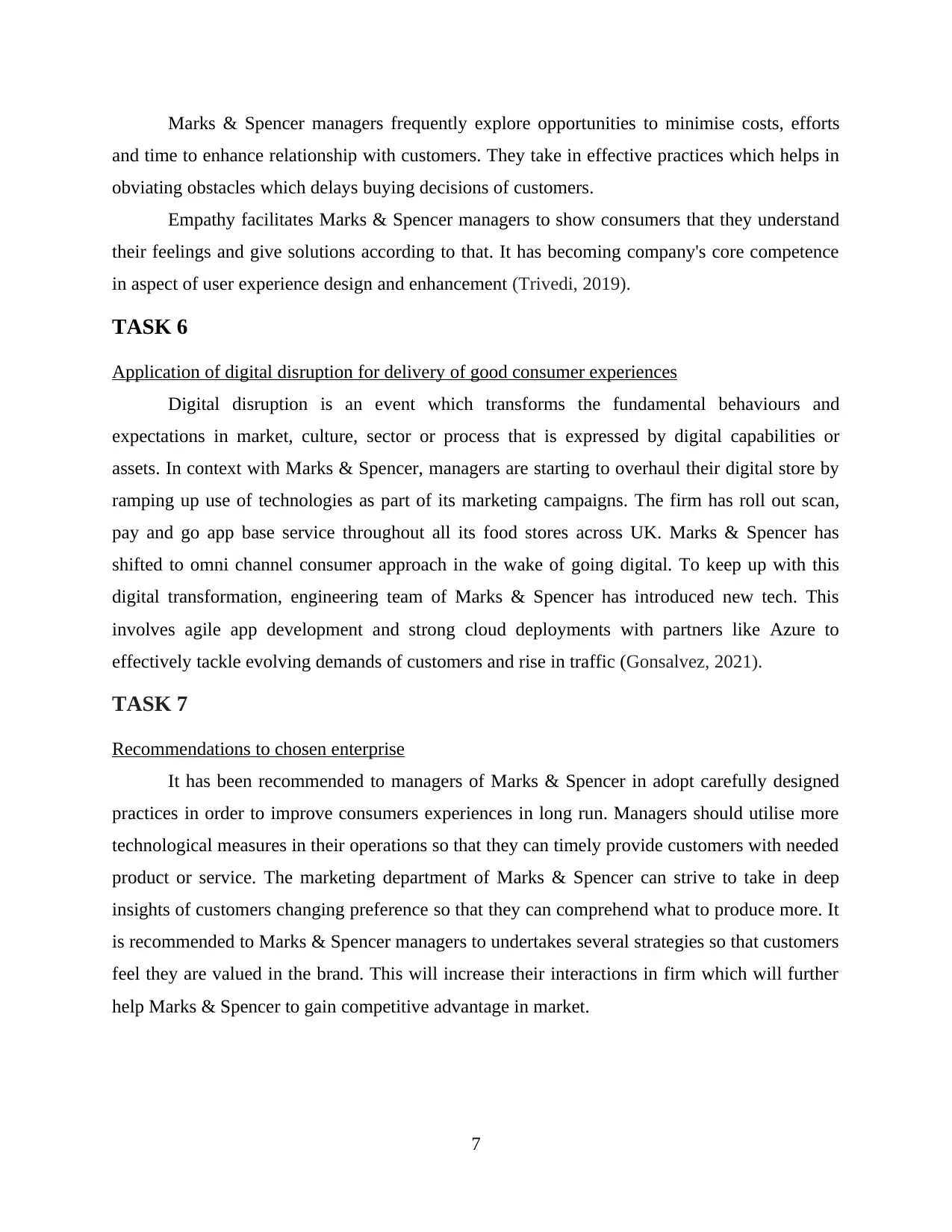
Marks & Spencer managers frequently explore opportunities to minimise costs, efforts
and time to enhance relationship with customers. They take in effective practices which helps in
obviating obstacles which delays buying decisions of customers.
Empathy facilitates Marks & Spencer managers to show consumers that they understand
their feelings and give solutions according to that. It has becoming company's core competence
in aspect of user experience design and enhancement (Trivedi, 2019).
TASK 6
Application of digital disruption for delivery of good consumer experiences
Digital disruption is an event which transforms the fundamental behaviours and
expectations in market, culture, sector or process that is expressed by digital capabilities or
assets. In context with Marks & Spencer, managers are starting to overhaul their digital store by
ramping up use of technologies as part of its marketing campaigns. The firm has roll out scan,
pay and go app base service throughout all its food stores across UK. Marks & Spencer has
shifted to omni channel consumer approach in the wake of going digital. To keep up with this
digital transformation, engineering team of Marks & Spencer has introduced new tech. This
involves agile app development and strong cloud deployments with partners like Azure to
effectively tackle evolving demands of customers and rise in traffic (Gonsalvez, 2021).
TASK 7
Recommendations to chosen enterprise
It has been recommended to managers of Marks & Spencer in adopt carefully designed
practices in order to improve consumers experiences in long run. Managers should utilise more
technological measures in their operations so that they can timely provide customers with needed
product or service. The marketing department of Marks & Spencer can strive to take in deep
insights of customers changing preference so that they can comprehend what to produce more. It
is recommended to Marks & Spencer managers to undertakes several strategies so that customers
feel they are valued in the brand. This will increase their interactions in firm which will further
help Marks & Spencer to gain competitive advantage in market.
7
and time to enhance relationship with customers. They take in effective practices which helps in
obviating obstacles which delays buying decisions of customers.
Empathy facilitates Marks & Spencer managers to show consumers that they understand
their feelings and give solutions according to that. It has becoming company's core competence
in aspect of user experience design and enhancement (Trivedi, 2019).
TASK 6
Application of digital disruption for delivery of good consumer experiences
Digital disruption is an event which transforms the fundamental behaviours and
expectations in market, culture, sector or process that is expressed by digital capabilities or
assets. In context with Marks & Spencer, managers are starting to overhaul their digital store by
ramping up use of technologies as part of its marketing campaigns. The firm has roll out scan,
pay and go app base service throughout all its food stores across UK. Marks & Spencer has
shifted to omni channel consumer approach in the wake of going digital. To keep up with this
digital transformation, engineering team of Marks & Spencer has introduced new tech. This
involves agile app development and strong cloud deployments with partners like Azure to
effectively tackle evolving demands of customers and rise in traffic (Gonsalvez, 2021).
TASK 7
Recommendations to chosen enterprise
It has been recommended to managers of Marks & Spencer in adopt carefully designed
practices in order to improve consumers experiences in long run. Managers should utilise more
technological measures in their operations so that they can timely provide customers with needed
product or service. The marketing department of Marks & Spencer can strive to take in deep
insights of customers changing preference so that they can comprehend what to produce more. It
is recommended to Marks & Spencer managers to undertakes several strategies so that customers
feel they are valued in the brand. This will increase their interactions in firm which will further
help Marks & Spencer to gain competitive advantage in market.
7
Paraphrase This Document
Need a fresh take? Get an instant paraphrase of this document with our AI Paraphraser
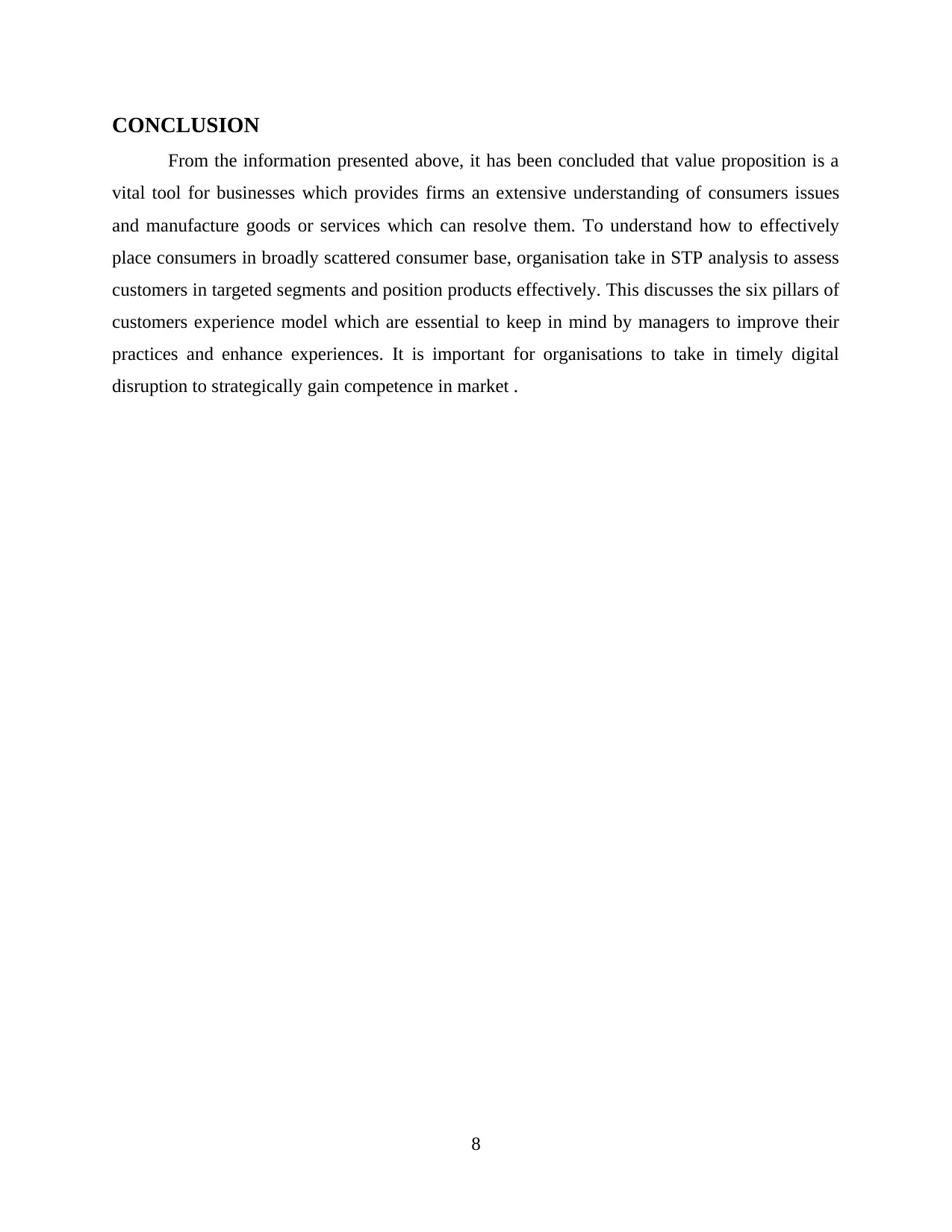
CONCLUSION
From the information presented above, it has been concluded that value proposition is a
vital tool for businesses which provides firms an extensive understanding of consumers issues
and manufacture goods or services which can resolve them. To understand how to effectively
place consumers in broadly scattered consumer base, organisation take in STP analysis to assess
customers in targeted segments and position products effectively. This discusses the six pillars of
customers experience model which are essential to keep in mind by managers to improve their
practices and enhance experiences. It is important for organisations to take in timely digital
disruption to strategically gain competence in market .
8
From the information presented above, it has been concluded that value proposition is a
vital tool for businesses which provides firms an extensive understanding of consumers issues
and manufacture goods or services which can resolve them. To understand how to effectively
place consumers in broadly scattered consumer base, organisation take in STP analysis to assess
customers in targeted segments and position products effectively. This discusses the six pillars of
customers experience model which are essential to keep in mind by managers to improve their
practices and enhance experiences. It is important for organisations to take in timely digital
disruption to strategically gain competence in market .
8
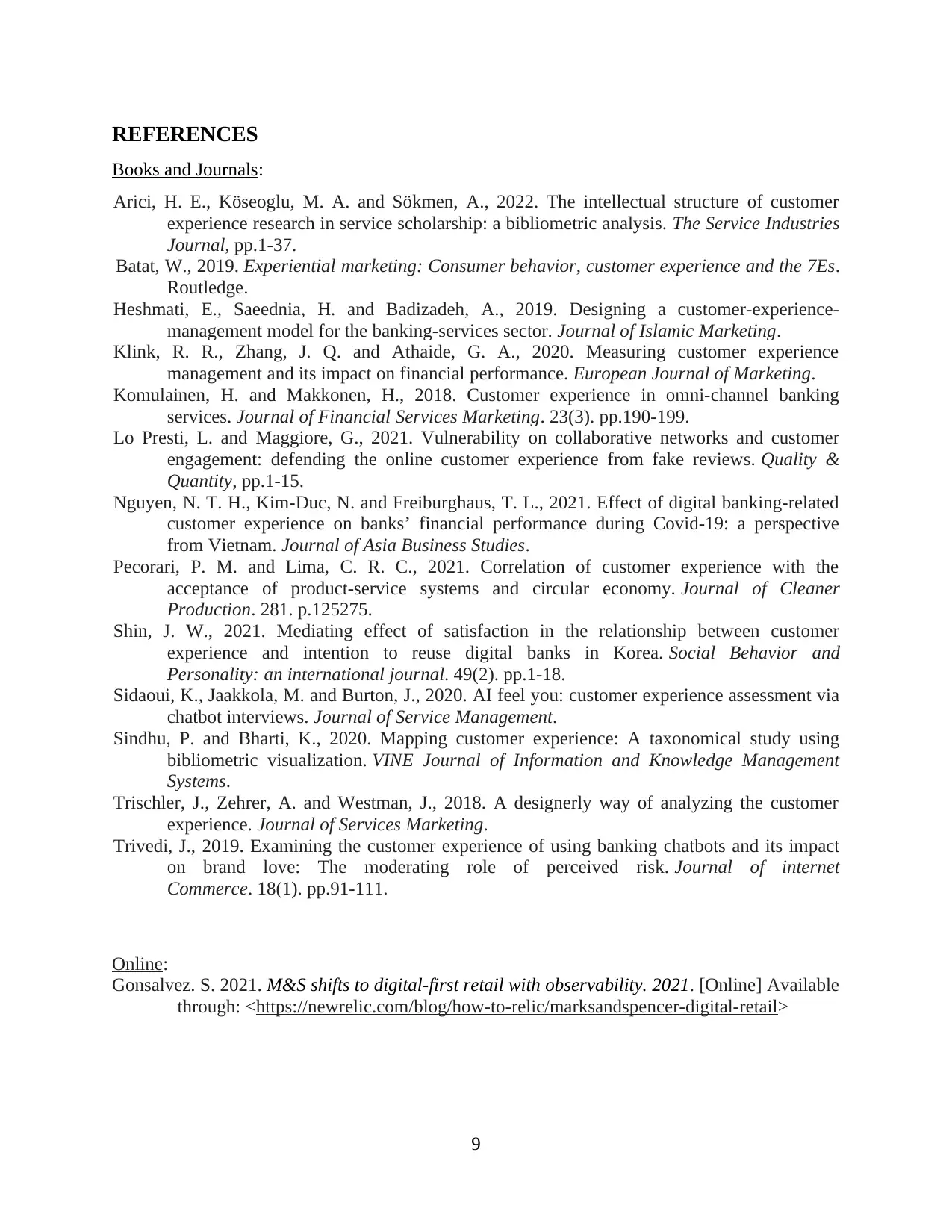
REFERENCES
Books and Journals:
Arici, H. E., Köseoglu, M. A. and Sökmen, A., 2022. The intellectual structure of customer
experience research in service scholarship: a bibliometric analysis. The Service Industries
Journal, pp.1-37.
Batat, W., 2019. Experiential marketing: Consumer behavior, customer experience and the 7Es.
Routledge.
Heshmati, E., Saeednia, H. and Badizadeh, A., 2019. Designing a customer-experience-
management model for the banking-services sector. Journal of Islamic Marketing.
Klink, R. R., Zhang, J. Q. and Athaide, G. A., 2020. Measuring customer experience
management and its impact on financial performance. European Journal of Marketing.
Komulainen, H. and Makkonen, H., 2018. Customer experience in omni-channel banking
services. Journal of Financial Services Marketing. 23(3). pp.190-199.
Lo Presti, L. and Maggiore, G., 2021. Vulnerability on collaborative networks and customer
engagement: defending the online customer experience from fake reviews. Quality &
Quantity, pp.1-15.
Nguyen, N. T. H., Kim-Duc, N. and Freiburghaus, T. L., 2021. Effect of digital banking-related
customer experience on banks’ financial performance during Covid-19: a perspective
from Vietnam. Journal of Asia Business Studies.
Pecorari, P. M. and Lima, C. R. C., 2021. Correlation of customer experience with the
acceptance of product-service systems and circular economy. Journal of Cleaner
Production. 281. p.125275.
Shin, J. W., 2021. Mediating effect of satisfaction in the relationship between customer
experience and intention to reuse digital banks in Korea. Social Behavior and
Personality: an international journal. 49(2). pp.1-18.
Sidaoui, K., Jaakkola, M. and Burton, J., 2020. AI feel you: customer experience assessment via
chatbot interviews. Journal of Service Management.
Sindhu, P. and Bharti, K., 2020. Mapping customer experience: A taxonomical study using
bibliometric visualization. VINE Journal of Information and Knowledge Management
Systems.
Trischler, J., Zehrer, A. and Westman, J., 2018. A designerly way of analyzing the customer
experience. Journal of Services Marketing.
Trivedi, J., 2019. Examining the customer experience of using banking chatbots and its impact
on brand love: The moderating role of perceived risk. Journal of internet
Commerce. 18(1). pp.91-111.
Online:
Gonsalvez. S. 2021. M&S shifts to digital-first retail with observability. 2021. [Online] Available
through: <https://newrelic.com/blog/how-to-relic/marksandspencer-digital-retail>
9
Books and Journals:
Arici, H. E., Köseoglu, M. A. and Sökmen, A., 2022. The intellectual structure of customer
experience research in service scholarship: a bibliometric analysis. The Service Industries
Journal, pp.1-37.
Batat, W., 2019. Experiential marketing: Consumer behavior, customer experience and the 7Es.
Routledge.
Heshmati, E., Saeednia, H. and Badizadeh, A., 2019. Designing a customer-experience-
management model for the banking-services sector. Journal of Islamic Marketing.
Klink, R. R., Zhang, J. Q. and Athaide, G. A., 2020. Measuring customer experience
management and its impact on financial performance. European Journal of Marketing.
Komulainen, H. and Makkonen, H., 2018. Customer experience in omni-channel banking
services. Journal of Financial Services Marketing. 23(3). pp.190-199.
Lo Presti, L. and Maggiore, G., 2021. Vulnerability on collaborative networks and customer
engagement: defending the online customer experience from fake reviews. Quality &
Quantity, pp.1-15.
Nguyen, N. T. H., Kim-Duc, N. and Freiburghaus, T. L., 2021. Effect of digital banking-related
customer experience on banks’ financial performance during Covid-19: a perspective
from Vietnam. Journal of Asia Business Studies.
Pecorari, P. M. and Lima, C. R. C., 2021. Correlation of customer experience with the
acceptance of product-service systems and circular economy. Journal of Cleaner
Production. 281. p.125275.
Shin, J. W., 2021. Mediating effect of satisfaction in the relationship between customer
experience and intention to reuse digital banks in Korea. Social Behavior and
Personality: an international journal. 49(2). pp.1-18.
Sidaoui, K., Jaakkola, M. and Burton, J., 2020. AI feel you: customer experience assessment via
chatbot interviews. Journal of Service Management.
Sindhu, P. and Bharti, K., 2020. Mapping customer experience: A taxonomical study using
bibliometric visualization. VINE Journal of Information and Knowledge Management
Systems.
Trischler, J., Zehrer, A. and Westman, J., 2018. A designerly way of analyzing the customer
experience. Journal of Services Marketing.
Trivedi, J., 2019. Examining the customer experience of using banking chatbots and its impact
on brand love: The moderating role of perceived risk. Journal of internet
Commerce. 18(1). pp.91-111.
Online:
Gonsalvez. S. 2021. M&S shifts to digital-first retail with observability. 2021. [Online] Available
through: <https://newrelic.com/blog/how-to-relic/marksandspencer-digital-retail>
9
⊘ This is a preview!⊘
Do you want full access?
Subscribe today to unlock all pages.

Trusted by 1+ million students worldwide
1 out of 12
Related Documents
Your All-in-One AI-Powered Toolkit for Academic Success.
+13062052269
info@desklib.com
Available 24*7 on WhatsApp / Email
![[object Object]](/_next/static/media/star-bottom.7253800d.svg)
Unlock your academic potential
Copyright © 2020–2025 A2Z Services. All Rights Reserved. Developed and managed by ZUCOL.


![Consumer Behaviour and Insight Report - Marketing at [University Name]](/_next/image/?url=https%3A%2F%2Fdesklib.com%2Fmedia%2Fimages%2Fnd%2Fd0d9f6191ecf4cd1a2dfa7b170111905.jpg&w=256&q=75)